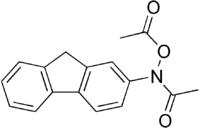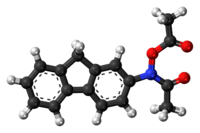Acetoxyacetylaminofluorene
 | |
 | |
| Names | |
|---|---|
| IUPAC name
[Acetyl(9H-fluoren-2-yl)amino] acetate[1] | |
| Other names | |
| Identifiers | |
| 3D model (JSmol) |
|
| Abbreviations | NAAAF |
| ChEBI | |
| ChemSpider | |
| MeSH | Acetoxyacetylaminofluorene |
| PubChem CID |
|
| |
| |
| Properties | |
| C17H15NO3 | |
| Molar mass | 281.31 g·mol−1 |
| log P | 3.327 |
| Except where otherwise noted, data are given for materials in their standard state (at 25 °C [77 °F], 100 kPa). | |
| | |
| Infobox references | |
Acetoxyacetylaminofluorene is a derivative of 2-acetylaminofluorene used as a biochemical tool in the study of carcinogenesis. It forms adducts with DNA by reacting with guanine at its C-8 position.;[1] This results in breaks in one strand of the DNA.
See also
References
This article is issued from
Wikipedia.
The text is licensed under Creative Commons - Attribution - Sharealike.
Additional terms may apply for the media files.